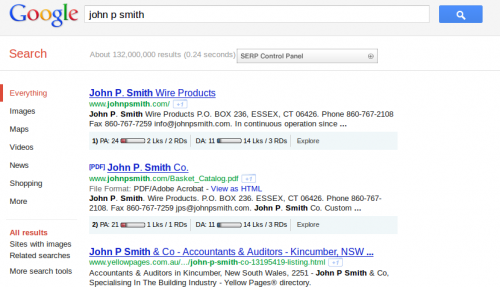This is a guest post by a chap named Devin Anderson.
And get your mind out of the gutter people! 😉 I know you went there!
This is actually quite an informative read on making yourself prominent in the Google SERPS for your name. Hopefully I don’t have to tell you how valuable that can be.
I’d appreciate if you’d make him feel welcome in the comments below and drop any questions you may have for him there.
Are you sick of reading about more important people with your name? Wouldn’t it be great if the results you see were actually about you?
By populating the Search-Engine Results Page (SERP) with media you control, you can make this happen.
Owning the Google Results Page allows you to:
- Control what a potential employer sees when they Google you
- Promote your business online
- Bury any bad press you may have gotten in the past
- Confidently tell girls to “Google Me” instead of exchanging phone numbers. (Warning: Not as smooth as it sounds on paper!)
Step 1: Choose a Name
This is the most important part of the entire process. Why? Because the more unique your name is, the easier it will be for Google to find you.
If you are lucky enough to have a somewhat original name then you can skip this section. This is for all the John Smiths, James Browns and Katy Perrys out there who want to set themselves apart from others who have their name.
The easiest way to re-brand a common, or celebrity, name is to include an extra initial or middle name.
EG: John P. Smith or Katy Madeline Perry.
It is crucial that those who Google you know to include your middle name or initial. In order to make this happen, you’ll need to start referring to yourself like this in all your professional communications. Job applications, business cards, author credits, interviews… anything you can think of!
Step 2: Get a Website
There are two things you want to bear in mind when registering a domain:
- Your name in the URL
- An extension relevant to your country.
E.G www.JohnPSmith.com (America) www.RichardChopin.fr (France)
After the URL, the next most important place to include your name is in the Meta Title of the homepage. Be as specific as possible with your Meta Title. Try to limit it to just your name + a very brief description of yourself.
This guy is doing it right!
When filling your website with content, make sure you include your name several times. This will come naturally if you write about yourself in the third person – which most resumé editors recommend doing anyway.
If including images of yourself, be sure to include your name in the Title and Alt Description of the image files. These may pop up in Google Images.
Once this is done, submit your website to Google and other search-engines. It should appear on the first page for your named-searches within a couple of days (as per the illustrated example). Once that’s done, the next will be to control the rest of the SERP.
Step 3: Get Your Social On
Twitter, LinkedIn, Youtube, Google Plus, Vimeo… even if you don’t plan on using these for networking, they are excellent ways to supplement your website and fill the SERP with you.
-
LinkedIn
LinkedIn profiles typically rank quite high for named-searches. Include your middle name (if using it) and be sure to link back to your homepage.
-
Twitter
Again, in your account details, include your full name. Try to include your full name in your @username as well if possible as this will help your profile rank higher. Complete a short bio and link back to your homepage. It’s not necessary to actually engage with Twitter if you don’t want to.
I would, however, recommend that you follow a couple of leaders in your industry and tweet a few times at the beginning. Once Google has indexed your profile and you’ve floated out a couple of intelligent tweets you can feel free to move on.
-
Youtube & Vimeo
Ever been involved in a presentation or interview that you were particularly proud of? Starred in a commercial or produced a short film? Stick it up on these websites and include your name in both the title and description of the video.
These days you’re increasingly likely to see videos and images among the regular text results on Bing and Google. It’s therefore important to spread your eggs among a variety of media-baskets if you want to totally dominate your SERP.
-
Blogging
It would be hard to overestimate the power of blogging when it comes to online reputation management. If you want to establish yourself as an expert in your industry, a blog is a great way to go about doing this.
The only downside is that it takes a significant amount of time to update a blog regularly.
Follow the guidelines as above for naming and designing your blog site, but make sure the content is distinctly different to the content on your main website. Creating, what’s called, ‘duplicate content’ will cause all sorts of SEO problems later.
I recommend starting with WordPress and installing Yoast’s WordPress SEO plugin. There are plenty of online guides to help you get your blog up and running so have a search around!
Step 4: Become an Author
So you’ve got a website, a Twitter profile, a LinkedIn page, a handful of Youtube videos, and maybe even a blog. Now it’s time to tie it all together!
Google recently begun listing author information along with search results. This allows you to be recognised by the SERPs for content which you helped produce and articles you’ve had published on other websites.
To do this, create a Google Plus account and follow these steps to becoming an author in the eyes of Google. It won’t take long and will prevent other John Smiths from getting credit for your work later on.
Step 5: Get Your PR On!
Do anything you can to get yourself published in the newspaper (within reason!). If an opportunity arises to be interviewed, take it. Sponsor or organise a local event. Run a campaign for charity. Be creative.
Newspapers and other old publications tend to have high-ranking websites. If your name is published in the local paper you can be almost certain that your good deeds will be indexed by The Big G.
Final Note For Business Owners
If you run your own business be sure to submit a listing to Google Places and as many local business directories you can find.
This will help push your website up towards number 1 in the SERP and, in the case of big sites like Yellowpages.com, provide you with an additional positive search result.
Please leave a comment if you’ve any questions or if you’d like me to go into further detail on any of the above steps!
And if you liked/loved/adored this post… please tell your pals about it and share it. You know I <3 you for it! 😀 Also as a complimentary addition to the information in the above post, be sure to check out Ana’s post on Googling yourself as well.


